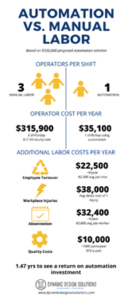
The promise of RPA and AI have been the same since their inception: you can do more with less. This is the exact problem many companies are now faced with in the 2nd of half of 2022 and going into 2023. Based on the predictions of some of the world’s leading financial minds, we are headed towards a recession that puts significant financial pressure on everyone. A example is the emerging threat of stagflation which is higher prices without revenue growth could create a troubling scenario. Despite the current labor market, in which there are more jobs than applicants, these open jobs might soon no longer be available.
Despite these indicators, companies are doubling down on tech spending. A recent study indicated companies are going to increase their overall budget in the areas of AI, RPA and cloud-based technologies. While the labor shortage has created a massive headache in acquiring and keeping a new employee, the fundamentals around creating an automation solution versus hiring an employee is significantly less. Consider the following infographic from Dynamic Design Solutions recent article on the subject; the numbers are striking.

They are even more so if you look at the “Additional Labor Costs” outside of salary and benefits. The cost of bringing on an employee that is performing tasks such as data entry or even outsourcing this activity is much higher than building an automation practice. What we’re seeing now is companies are hiring people to administer and run bots to do repetitive work while the employee completes higher level tasks and responsibilities. With regards to some of the companies we work with, they have 100’s or 1000’s of employees performing similar tasks. The cost savings is significant when you factor in all of the related financial resources associated with hiring new employees. As profits become slimmer and companies try to contain inflation and sustain growth, Technology, and more specifically automation, will not be a revenue sinker, but rather a business and revenue driver.
Written by: Peter Camp, CTO & Founder



